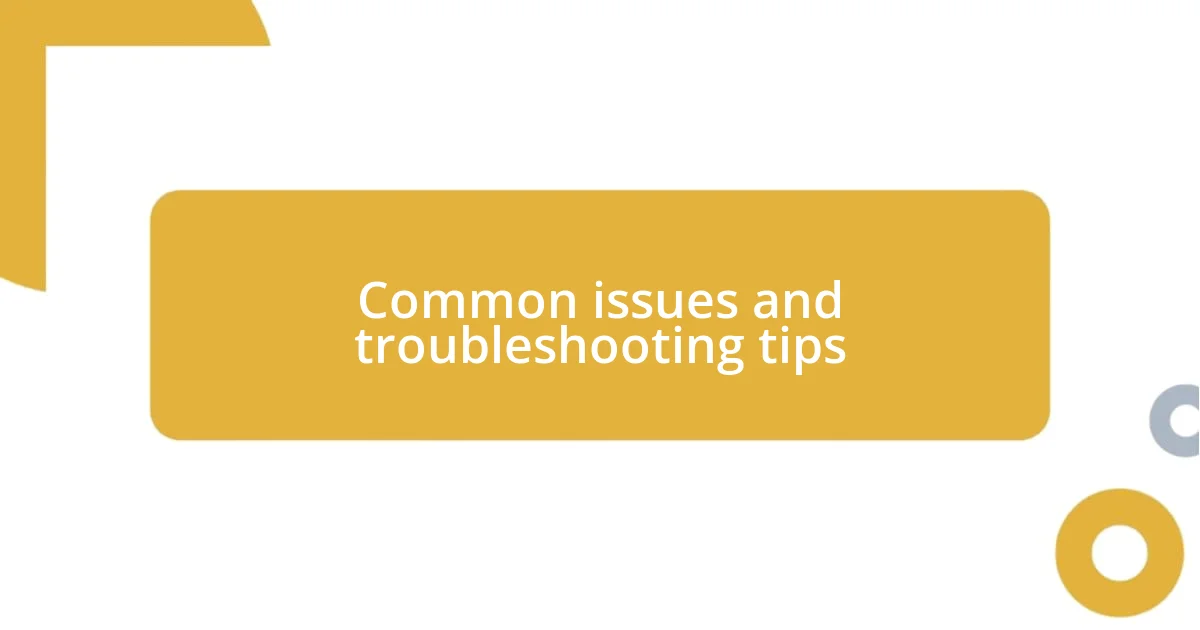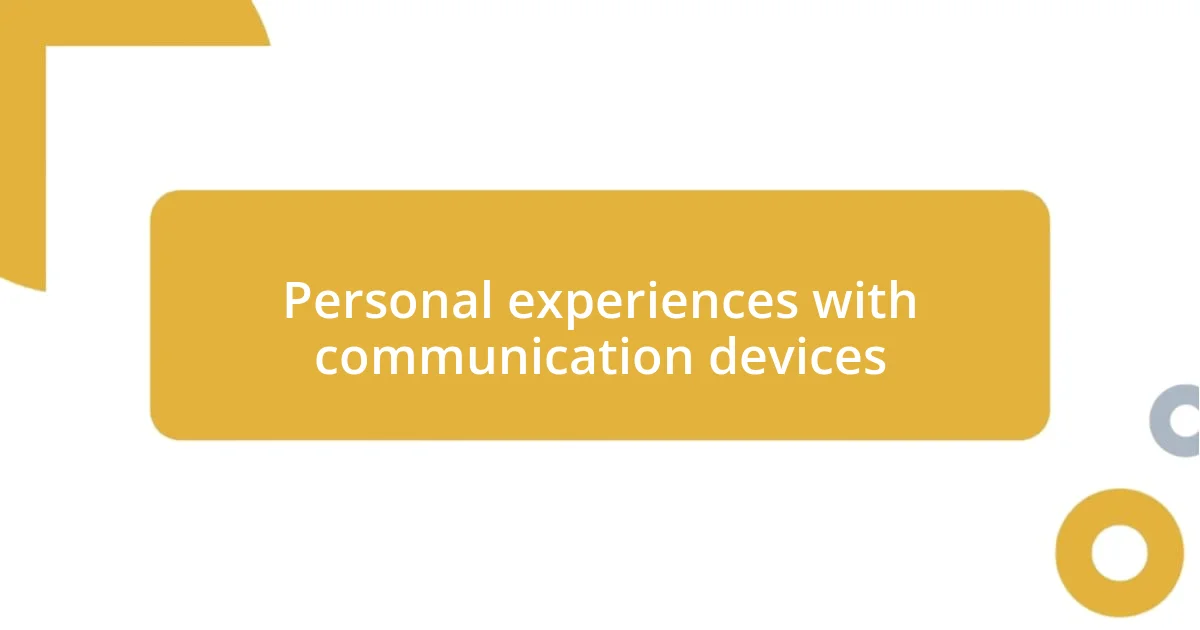Key takeaways:
- Communication devices, from landlines to smartphones, have transformed our interactions, raising questions about the depth and nature of modern connections.
- Choosing the right device is essential; it should align with individual communication needs and enhance personal or professional interactions.
- Common issues such as connectivity problems and device performance can disrupt communication, but being proactive with troubleshooting and maintenance can improve the experience significantly.

Introduction to communication devices
Communication devices have transformed the way we connect with each other, bridging distances that once felt insurmountable. I remember my first experience with a mobile phone as if it were yesterday; the thrill of being able to reach my friends anytime, anywhere was exhilarating. What was once a long-distance call now fits into our pockets, but how has this shift changed the essence of our conversations?
As I reflect on my journey with various communication devices, from landlines to smartphones, it’s fascinating to see how these tools have shaped our interactions. Each advancement has brought not just convenience but also new challenges—like the pressure to respond instantly. Are we truly better connected, or are we sometimes more isolated in this digital age?
Growing up in a time before the internet, I often wonder how communication devices like these have influenced our relationships and emotional expressions. I still cherish my handwritten letters exchanged with friends; they felt more personal. Now, in a world dominated by texts and emojis, the question lingers: Are we nurturing our connections, or are they simply superficial digital exchanges?

Types of communication devices
The variety of communication devices available today is impressive, each serving unique purposes in our daily lives. I often think about how my trusty landline telephones gradually gave way to the mobile devices I now can’t live without. Each type of device has its own charm and functionality, reminding me of different phases in my life where I relied heavily on them.
Here are some common types of communication devices I’ve encountered:
- Landlines: The classic way to connect, often associated with family gatherings or long conversations with friends. I remember rallying around the kitchen phone for gossiping with my closest pals.
- Mobile Phones: These have evolved significantly; I still get excited about the features on my smartphone. The ability to send messages instantly has reshaped my social interactions.
- Tablets: I find them perfect for video calls. Recording updates for family abroad became a joyful routine during the holidays.
- Laptops: Essential for work-related communication. I’ve experienced both the frustration and relief of using video conferencing tools for meetings.
- VoIP Devices: Internet phones have opened new avenues for international chats, making it personal and cost-effective. I’ve shared laughs across continents without the worry of hefty phone bills.
- Smart Assistants: I never imagined I’d be talking to a device in my home, but they’ve simplified routines and made communication hands-free. It’s a bit odd yet delightful when I ask my assistant about the weather while cooking.
Every device plays a role in our lives, weaving connections through their distinct channels. It’s a nostalgic journey to consider how these tools have shaped not just individual experiences but the way we collectively engage with each other in this fast-paced, digital world.

Choosing the right communication device
Choosing the right communication device can feel overwhelming with so many options available. Personally, I still recall the excitement of choosing my first smartphone; it was a big step for me. I wanted a device that was more than just a phone; it had to have all the apps I could imagine to truly keep me connected with family and friends—especially when they lived miles away.
When considering a communication device, think about your specific needs. For example, if you primarily want to stay in touch with loved ones, a simple smartphone should suffice. However, if you’re into professional video conferencing, investing in a laptop with a good webcam could significantly enhance your experience. I’ve found that letting my lifestyle dictate my device choice helps me avoid unnecessary complexities.
Ultimately, the best device for you should align with how you communicate, whether through texting, calling, or video chatting. A few months ago, I faced the dilemma of whether to upgrade my tablet for better video calls or stick with my laptop. Honestly, I chose the tablet, which turned out great for spontaneous video calls—and that flexibility made all the difference in my day-to-day life.
| Device Type | Ideal Use |
|---|---|
| Landline | Traditional conversations, family connections |
| Smartphone | Everyday communication and app usage |
| Tablet | Video calling and casual browsing |
| Laptop | Work meetings and professional usage |
| VoIP Devices | Cost-effective international calls |
| Smart Assistants | Hands-free communication and routine management |

Setting up communication devices
Setting up communication devices can be both exciting and daunting. I still remember the first time I unboxed my smartphone; it felt like unwrapping a gift. The anticipation built as I connected it to Wi-Fi and learned how to navigate the screen. It’s interesting how such moments shape our technological journey—much like assembling a new puzzle.
When I set up my tablet for video calls, I was thrilled to discover features that made communication smoother. Positioning the device at just the right angle for family gatherings over video felt like preparing for a performance. Have you ever fiddled with the camera until it captured your best side? Those small adjustments often define our experience and the connections we forge.
I’ve also had moments where the device setup didn’t go as planned, like when my laptop froze during a crucial work meeting. I learned that understanding the settings and ensuring software updates can make all the difference. It’s a reminder that preparation isn’t just about the initial setup but about maintaining the connection over time. Have you had technology hiccups that made you appreciate the smooth days even more?

Enhancing communication device performance
Enhancing the performance of communication devices is crucial for ensuring a seamless experience. One tip that always works for me is regularly updating software. I can’t stress enough how one time I neglected an update on my smartphone, and it caused frequent lag during video calls. The moment I updated, everything ran smoothly, and I felt a wave of relief knowing I wouldn’t have to awkwardly ask, “Can you hear me now?” again.
Another aspect I focus on is optimizing my device’s settings. For instance, I remember adjusting the brightness and sound settings on my tablet for better video clarity during family catch-up sessions. This small tweak made those moments feel vividly connected, and I could actually see and hear my loved ones without missing a detail. Have you ever thought about how much better your experience could be with just a few adjustments?
Lastly, I have embraced the world of accessories to elevate my communication. My favorite addition is my Bluetooth headset, which has given me so much freedom when multitasking. I recall one busy afternoon when I was cooking dinner while chatting with a friend. The headset allowed me to connect effortlessly, turning a mundane task into a lively conversation. It’s these little enhancements that transform a simple device into a personal communication powerhouse. Have you discovered any accessories that have changed how you stay in touch?

Common issues and troubleshooting tips
Sometimes, communication devices just don’t cooperate, and I’ve faced my fair share of glitches. I remember one time, my video call app crashed right as I was about to deliver an important presentation. It was frustrating! But I learned that closing unnecessary apps beforehand and ensuring a strong Wi-Fi connection could really save the day. Ever been in a similar situation where the tech just doesn’t play nice?
Another common issue I’ve encountered is the dreaded audio problems. I recall a family call when everyone was excited to share news, but half the people on the call were muted—pure chaos ensued! I quickly realized that checking the microphone settings and making sure everyone understands how to unmute can prevent that confusion. Have you ever had your friends or family looking like they were talking underwater?
Battery life can also be a sneaky thief in our communication experience. There have been countless times when I’ve been in the middle of a heartfelt conversation, and my phone suddenly dies. That’s why I now keep a portable charger handy, ensuring that I won’t miss any precious moments. After all, what good is advanced technology if it fails us at the worst possible time?

Personal experiences with communication devices
I remember my first experience with a communication device was on my old flip phone. When I got a message from a friend, the anticipation of waiting for the screen to light up was exhilarating! I felt so connected, even if it was just a simple “How are you?” text. It was fascinating how a small device allowed me to bridge distances and foster relationships, even back then.
Fast forward to my first video call on a laptop, which felt like stepping into the future. I was so nervous, making sure my background was tidy to impress my peers. I could almost feel the butterflies in my stomach as I waited for everyone to join. But the moment we all connected, and I heard their familiar voices, it was like having them right there with me. Have you felt that rush when you see someone you miss, even if only through a screen?
On the flip side, I’ve had my share of communication hurdles. I’ll never forget the time I was on a group call, attempting to coordinate a surprise party—but my connection was so spotty that it felt like I was talking to robots. The frustration was real as I watched my friends nod along without really hearing my ideas. It got me thinking: how often do we let technology hinder meaningful conversations?











